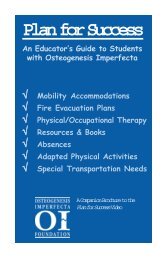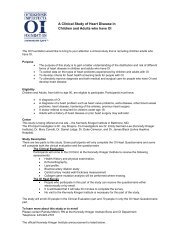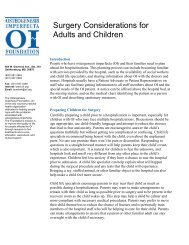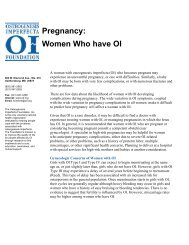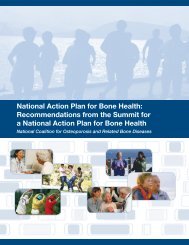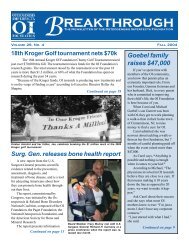Breakthrough - Osteogenesis Imperfecta Foundation
Breakthrough - Osteogenesis Imperfecta Foundation
Breakthrough - Osteogenesis Imperfecta Foundation
You also want an ePaper? Increase the reach of your titles
YUMPU automatically turns print PDFs into web optimized ePapers that Google loves.
Article<br />
Understanding medical research & literature<br />
by Hariett Patterson, MPH<br />
Reprinted with permission from<br />
The National Brain Tumor <strong>Foundation</strong><br />
When diagnosed with a serious<br />
illness or disorder, many people want<br />
to learn more about their condition and<br />
possible treatments. At some point,<br />
they may wish to consult medical<br />
journals and read research articles to<br />
find out about new treatment options.<br />
However, complicated medical and<br />
scientific jargon can be an obstacle to<br />
obtaining vital information. By following<br />
a few basic guidelines and learning<br />
a few research terms, the world of<br />
medical literature can become more<br />
understandable.<br />
To begin, it is helpful to know the<br />
basic structure of scientific papers.<br />
They generally begin with an abstract<br />
(a brief summary). Reading the<br />
abstract is a great way to get an<br />
overview of what the author was<br />
researching—the main question of the<br />
study—and the results. The rest of the<br />
paper will usually include the following<br />
sections: an introduction or background,<br />
methods, results, discussion<br />
and bibliography.<br />
The introduction or background<br />
section discusses the reasons the<br />
researcher was doing the study, and<br />
typically cites the previous studies. The<br />
methods section explains how the<br />
study sample participants were selected<br />
and how the study was conducted.<br />
(For example, through personal<br />
interviews or by examining hospital<br />
records.) The results section gives the<br />
data from the study and tends to<br />
present a lot of numbers (percentages<br />
and statistics). In the discussion<br />
section, the researcher analyzes the<br />
results in relation to the original<br />
research question and draws conclusions.<br />
The discussion section is generally<br />
less technical than the other<br />
sections of the paper. It can be a good<br />
way to get a summary of the findings<br />
and what they mean.<br />
Remember that research findings<br />
should be carefully interpreted. It is<br />
helpful to look for information in<br />
journals that are “peer-reviewed.” This<br />
means that other scientists and researchers<br />
in the field have had a<br />
chance to read and evaluate the<br />
studies before they are accepted and<br />
published by the journal. Major medical<br />
journals such as the Journal of the<br />
American Medical Association<br />
(JAMA) and the New England Journal<br />
of Medicine are peer-reviewed.<br />
Internet sites such as Medscape<br />
(www.medscape.com) and Pubmed<br />
(www.pubmed.gov) have directories<br />
of peer-reviewed journals and allow<br />
you to search by topic of interest.<br />
Some Internet sites are not<br />
reliable. If you read about a study on<br />
the Internet that sounds interesting and<br />
want to know more about it, it is a<br />
good idea to search the major research<br />
databases to see what they have<br />
published on the topic.<br />
Here are a few key terms and<br />
definitions to get you started:<br />
Clinical Trial – A research study<br />
conducted with patients to scientifically<br />
determine the effectiveness of new<br />
treatments or to improve existing ones.<br />
Each study tries to answer scientific<br />
questions and to find better ways to<br />
prevent, diagnose or treat diseases or<br />
disorders.<br />
Confidence Interval – A statistical<br />
range of values for a particular<br />
variable or characteristic, set up so<br />
that the variable lies within that range.<br />
(Example: The 95% confidence<br />
interval for height is 5’9” to 6’. This<br />
means that 95 out of 100 people will be<br />
within that height range.) Generally,<br />
the more narrow the confidence<br />
intervals, the more reliable the study<br />
results.<br />
Control – An individual or group<br />
used as a standard of comparison for<br />
checking or verifying the results of an<br />
experiment.<br />
Double-blind Study – A type of<br />
study in which neither the doctors nor<br />
participants know who is receiving a<br />
drug and who is receiving a placebo.<br />
This method helps to assure objective<br />
results by avoiding prejudice either for<br />
or against a treatment.<br />
Placebo – An inactive substance<br />
given as a control (standard for<br />
comparison) in an experiment to test<br />
the effectiveness of a drug.<br />
Qualitative Research – A study<br />
with findings that are not arrived at by<br />
looking at statistics. This type of<br />
research generally looks at opinions<br />
and personal viewpoints.<br />
Quantitative Research – A<br />
study that uses measurements and<br />
statistical methods to identify causes,<br />
make predictions, and determine if the<br />
findings of a study can be applied to<br />
the general population as a whole.<br />
Randomized Control Trial – A<br />
type of study where the participants<br />
are randomly selected to receive either<br />
a placebo or the treatment being used.<br />
Sample – The group of people<br />
that participate in a study. The sample<br />
may be random or may represent a<br />
particular population group.<br />
These terms are a good starting<br />
point to understanding medical research,<br />
but the best way to become<br />
more comfortable with scientific<br />
research is to start reading.<br />
Be sure to view the OI <strong>Foundation</strong>’s series of related fact sheets, including: Talking With Your Doctor,<br />
Talking With Your Orthopedist, and How To Bring Out the Best In Your Health Care Team. These and<br />
many other healthcare resources are available online at www.oif.org or by calling (800) 981-2663.<br />
Page 19 <strong>Breakthrough</strong> Winter 2004



